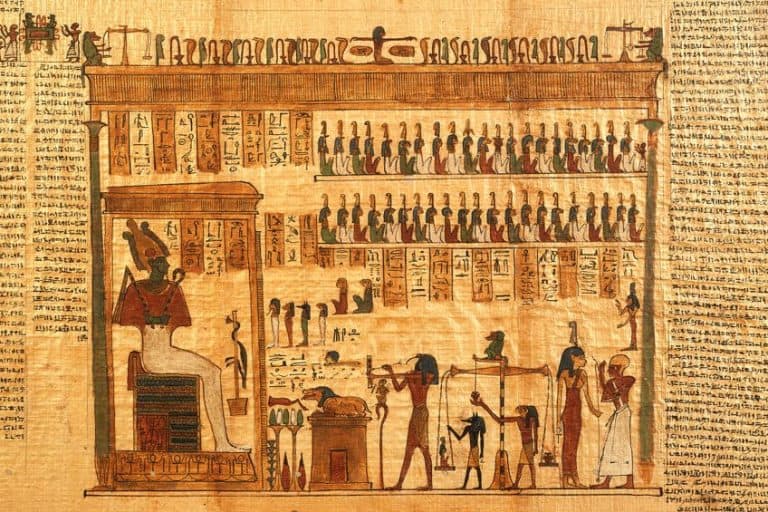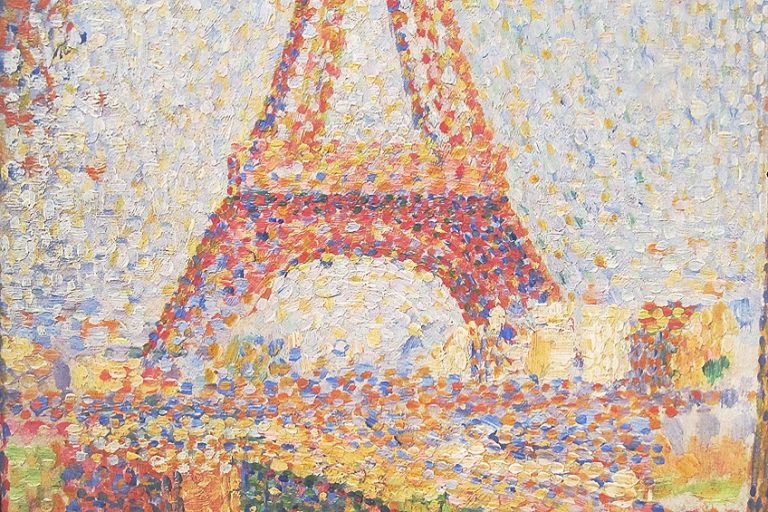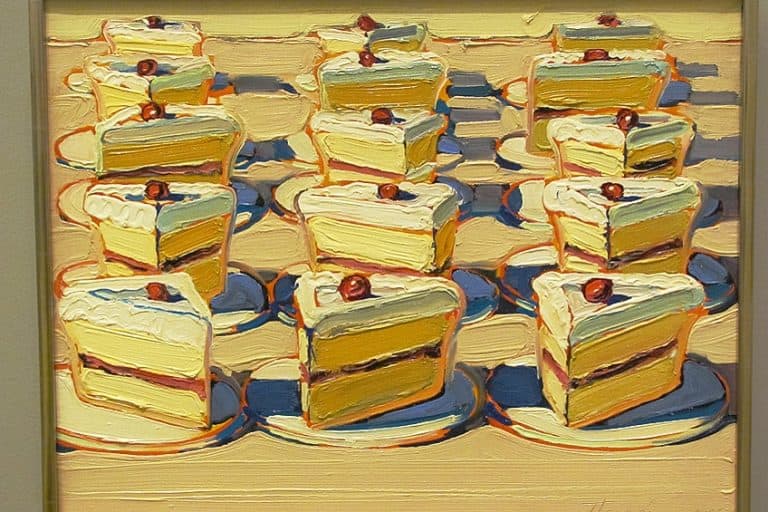“Nocturne in Black and Gold” – Whistler’s Falling Rocket Painting
Nocturne in Black and Gold – The Falling Rocket (c. 1877) by James Abbott McNeill Whistler is an artwork that typifies the art for art’s sake philosophy. A fireworks show in the cloudy night sky is seen in Whistler’s representation of the industrialized municipal park in The Falling Rocket painting. Today, we will be having a look at the Falling Rocket painting analysis and other important details.
Introducing Whistler’s Nocturne in Black and Gold – The Falling Rocket (c. 1877)
| Date Completed | c. 1877 |
| Medium | Oil on canvas |
| Dimensions | 60 cm x 46 cm |
| Current Location | Detroit Institute of Arts, Detroit |
One may argue that, for certain works of art, looking beyond the artist’s aim in order to construct a more ambiguous, personal interpretation is, paradoxically, the designer’s ultimate goal. The observer is urged to derive his own meaning, to build his own connections, much like Alice hesitantly going beyond the flat plane of the mirror into the worlds beyond. In this way, the observer is effectively participating in the artistic process itself.
While vagueness is common in today’s conceptual art, in the early artworks of America, what counted most was what might be understood on the exterior: storytelling coherence, expressionistic detail, naturalism, and unambiguous moral message. But when did things start to shift?
Things began to change probably around the time when avant-garde painters started to experiment with abstractions, experiment with modernity, and question traditional aesthetic norms. Let us take, for example, the Nocturne in Black and Gold – The Falling Rocket by James Abbott McNeill Whistler.

Museum visitors could see flames from a crackling campfire, glowing Japanese lanterns, or images of far-off constellations magically emerging on a bright summer evening in the swirl of gloomy dark colors, indistinct meandering forms, and bursts of dazzling color in the same picture. While the painting was motivated by a specific occurrence – fireworks shown above London’s Cremorne Gardens – the artwork’s intangibility, both in look and concept, was intended.
The issues it raises and the feelings it elicits may differ from one spectator to the next, which is precisely the idea.

Many 21st-century viewers find the picture appealing, yet when it was initially shown in a London gallery in 1877, critics thought it was too sloppy, unintelligible, and even disrespectful. Whistler’s work was rejected by art critic John Ruskin as “throwing a pot of paint in the front of the populace,” as it had no social significance in his opinion. As a result, Whistler, ever the audacious fellow, prosecuted Ruskin for libel, and while winning the case in court, he was only given a farthing in damages.
The creator justified his collection of environmental nocturnes as artistic compositions whose significance resided not in any imitative characteristics but in their foundation in transcendent principles of balance and beauty throughout the widely publicized trial.
About the Artist: James Abbott McNeill Whistler
| Nationality | American |
| Date of Birth | 11 July 1834 |
| Date of Death | 17 July 1903 |
| Place of Birth | Lowell, Massachusetts |
James Abbott McNeill Whistler’s ancestors were of Scottish and Irish descent. He resided in St. Petersburg, Russia, for a while, where his father was working as a civil engineer. He sailed back to the United States after a brief visit to England. James Whistler attended the United States Military Academy before leaving the service to pursue a career in painting. Paris enchanted him, as it did many other artists at the time. In 1855, he moved there to study art and soon began embracing a carefree life.
Whistler was also influenced by the modernist movement in France. He also embraced realism, which was popularized by painters like François Bonvin, Henri Fantin-Latour, and Gustave Courbet.

The artist spent the 1860s traveling between the United Kingdom and Paris. In 1861, he visited Brittany, and in 1862, he visited the seaside area around Biarritz. He began painting with Courbet during this period and acquired a passion for the water. Some of his later oil works and watercolors include the sea.
In 1863, he moved to London, where the Thames provided him with inspiration. James Abbott McNeill Whistler’s most productive years were the 1860s and 1807. During this time, he began assigning musical titles to his pieces. He demonstrated that he believed in the philosophy of art for the sake of art by doing so. Nevertheless, it should be noted that the artist was not a music lover in and of itself.
He began painting nocturnes of numerous locations in London during this period, with a particular concentration on Chelsea.
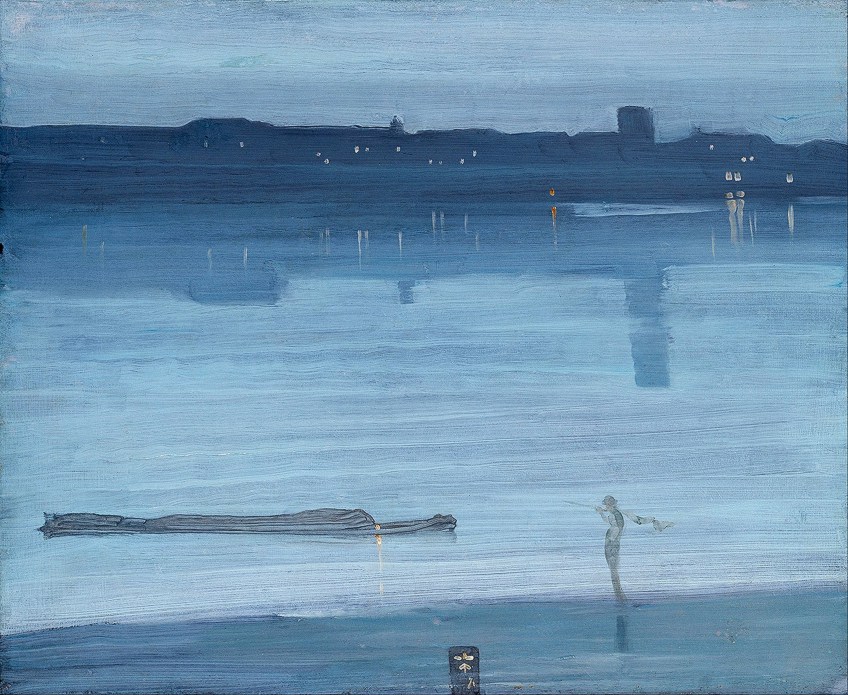
He experienced many troubles in his final years in the 1890s. For one thing, he appeared to be behind the times. In the 1890s, the impressionist style was gaining steam, but he never adopted the Impressionists’ vivid colors or methods.
Furthermore, despite the fact that color lithographs were very fashionable at the time, he only produced roughly four of them in color.
Whistler spent the final few years of his life attempting to gain an advantage over Oscar Wilde in a long-running feud and attempting to obtain recognition. In 1888, he wedded Beatrix Godwin, and when she died in 1896, he was devastated, and his latter years were terribly melancholy. His paintings began to lose favor in the early 1890s.

A Falling Rocket Painting Analysis
The artwork exudes a degree of color-rich brilliance that creates spatial ambiguity against a line and form framework. Nocturnes was a series of paintings that were evocative of various nighttime landscapes through their painterly approach.
The artist argued that these were scenarios or events, not paintings.
In this piece, Whistler can be seen fighting for painting’s inherent distinctiveness from literature, like color and tone triumph over indications of the story or moral allusion, working against contemporary impulses for narrative symptomatic of heavy consumption of reading.

Whistler concentrated on coloristic effects as a technique of evoking a specific feeling. More than just that, a Nocturne is preoccupied with its representation of space, attempting to capture a unique sensation of vacuum that only appears at night. The artwork, which is associated with the “art for art’s sake” concept, aims to elicit complex feelings that transcend beyond the mechanics of the visual. James Abbott McNeill Whistler thought that subtlety and implication were frequently the best ways to communicate certain emotions.
These arrangements were not intended to obscure the truth of a scene, but rather to reveal deeper, more buried realities.
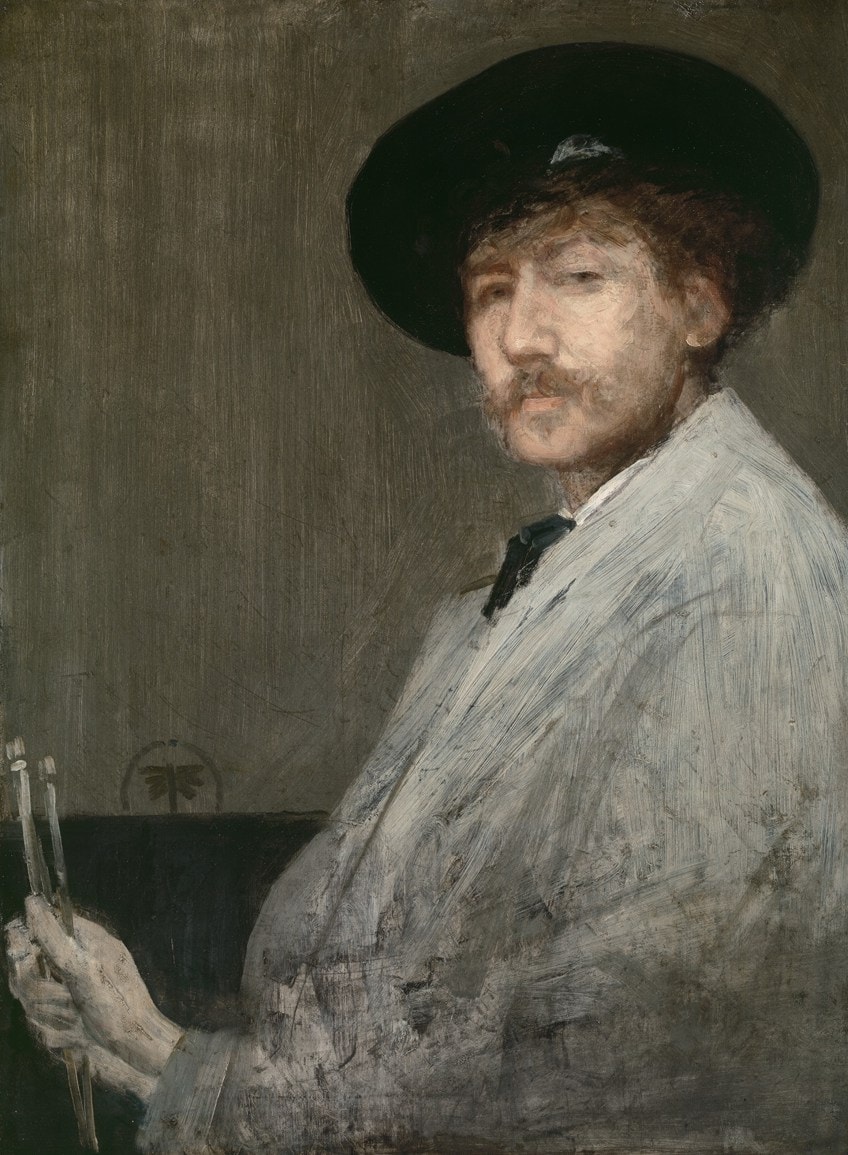
His creative pursuits were no longer focused on physical precision, but rather on capturing the spirit of an intangible, emotional, and intimate moment. “If the person who paints merely the tree, blossom, or other material he observes before him were a painter, the king of painters would be the photographer,” Whistler is reported as saying. “It is up to the creator to go above and beyond”. In principle, Nocturne in Black and Gold – The Falling Rocket by James Abbott McNeill Whistler is a composite of a London fireworks spectacle, although it makes no attempt to imitate it.
The painting is designed to be viewed as an arrangement, with certain experiences in mind for the viewer.
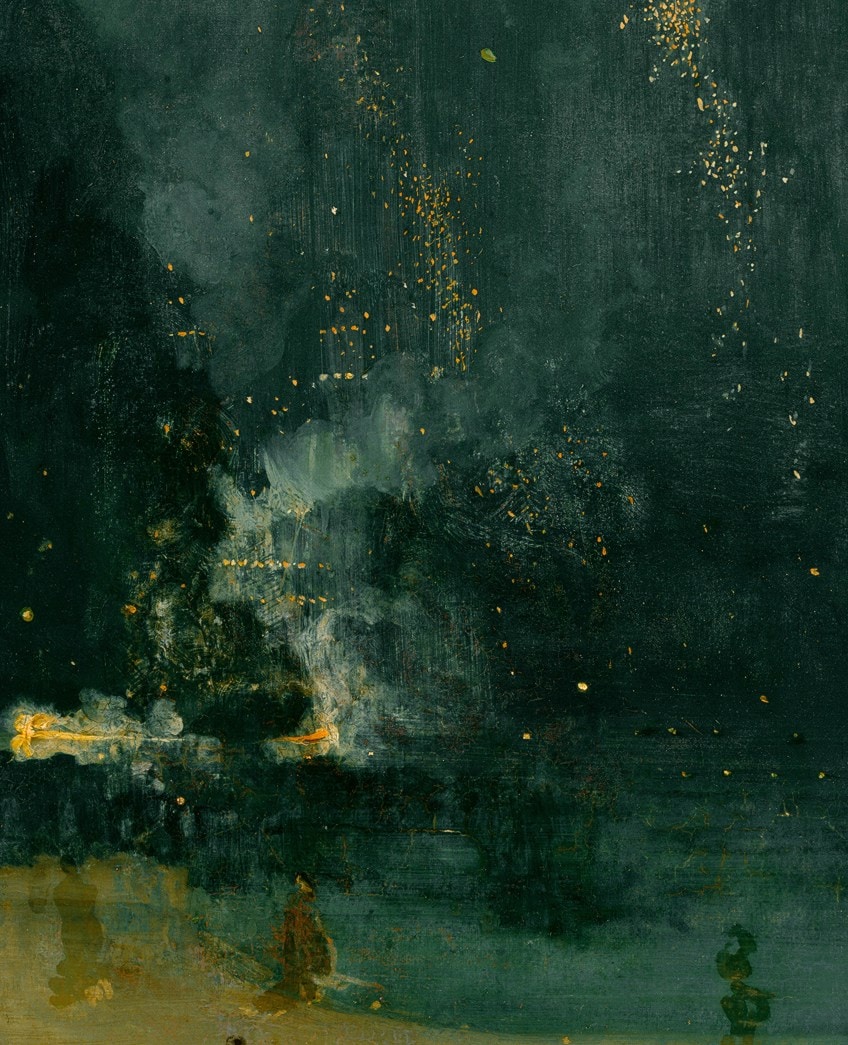
Nocturne in Black and Gold – The Falling Rocket Composition
This piece is mostly made up of gloomy tones with three primary colors: green, blue, and yellow. The painting develops a subdued yet harmonious arrangement because of its limited usage of colors. The blowing smoke creates an obvious barrier between the sea and the sky, which eventually melts into a single, solemn place. The title rocket is represented by a massive avalanche of fog.
As bursting fireworks in the foggy air, dabs of yellow brighten the artwork. The figures observed are virtually translucent, with simple and generic outlines.
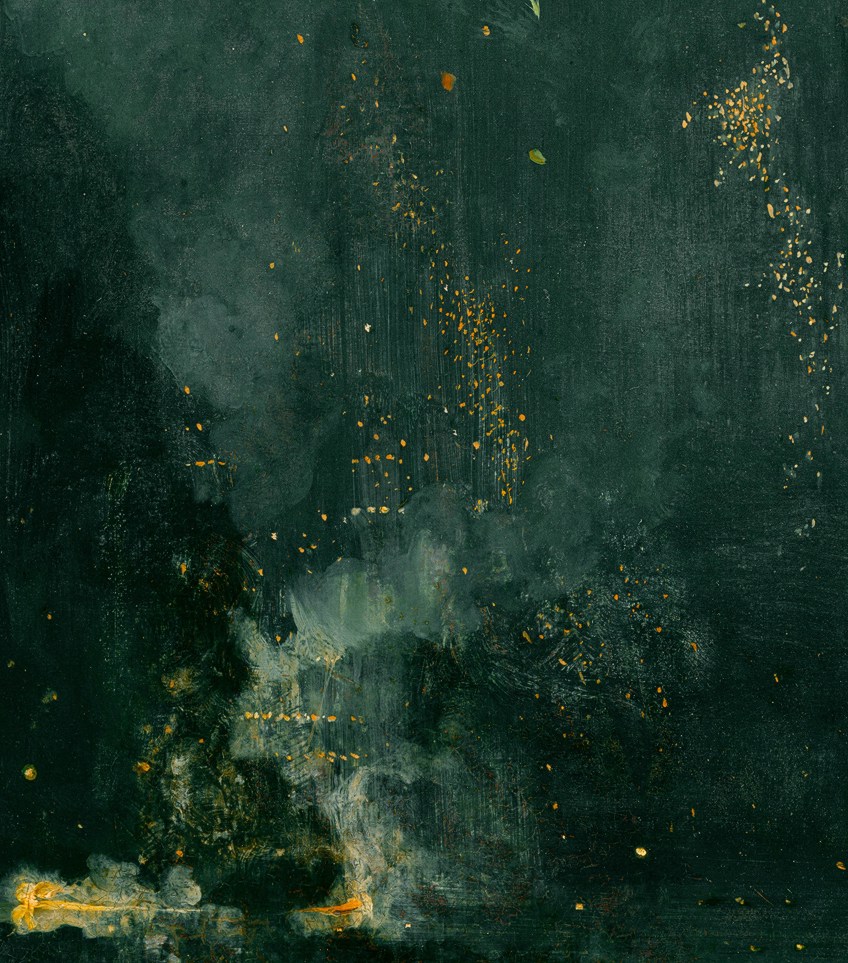
To the left, the artist writes his name with broad, straight brushstrokes that look to resemble Japanese letters, definitely influenced by Japanese prints. Whistler spent years honing his splatter method, inspired by Japanese painters such as Utagawa Hiroshige.
With what looked to be nothing more than a mere swipe of paint, he eventually developed the capacity to create an item or a person.
Although Whistler’s critics slammed his method as rash or lacking in artistic quality, it’s worth noting that he spent a lot of time paying attention to the smallest details, even going so far as to look at his work via mirrors to make sure no flaws were unnoticed.
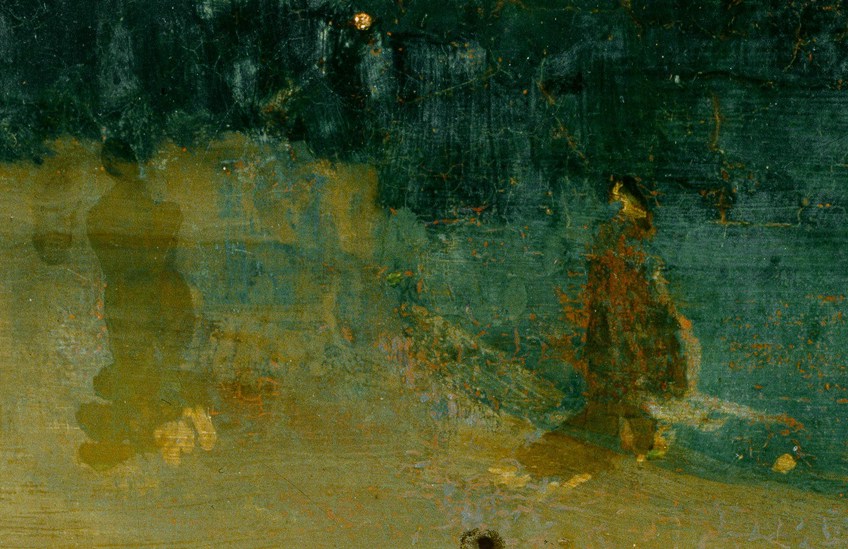
Controversies
When confronted with the painting, John Ruskin criticized James Abbott McNeill Whistler for “chucking a pitcher of paint in the face of the people”. Ruskin’s scathing criticism of the picture, as a famous Victorian art critic, sparked outrage among owners of other Whistler pieces.
Having a Whistler artwork quickly became a source of embarrassment, putting the artist more in debt.
Whistler sued Ruskin for libel in defense, putting his dignity, riches, and the value of his Nocturne on the line. He encouraged the jurors in court to look at it as an artistic composition rather than a typical painting. He asserted that the artwork was a portrayal of the Cremorne Gardens pyrotechnics in his response.
“Not a perspective of the Cremorne?” queried Sir John Holker during the hearing, to which Whistler replied, “If it were a vista of Cremorne, it would undoubtedly bring nothing but regret on the behalf of the beholders”. His argument was harmed, however, when The Falling Rocket was handed to the jury upside down. In front of the judge, his description of the composition was ineffective.
He did not lose, but he only came away with a farthing. He had no alternative but to file for bankruptcy after all the legal bills. Whistler was compelled to sell, barter, and mortgage whatever he could get his hands on in order to make ends meet.
When John Ruskin condemned The Falling Rocket as becoming a public disgrace, he was unaware of the labor and philosophy that had gone into Nocturne in Black and Gold. Long before the trial, Ruskin had chastised Whistler’s works. He had called Whistler’s paintings “absolute garbage” four years before. Ruskin was also said to be envious of Whistler’s strong friendship with Charles Augustus Howell, who frequently assisted Whistler financially, particularly after the court battle.

Ruskin was believed to be angered by the artist’s lack of homage. The art critic’s remark bothered Whistler, but he wasn’t the only one. One person who came out against Ruskin was Henry James, who stated that Ruskin had started to overstep his limits as an art critic, growing authoritarian in his language — to the point that seeing him dragged to court for his insulting remarks was considered a thrill. It has been argued that John Ruskin was afflicted with CADASIL syndrome and that the visual problems he experienced as a result of this disease may have contributed to his annoyance with this artwork.
That concludes our look at “Nocturne in Black and Gold – The Falling Rocket” by James Abbott McNeill Whistler. Whistler may be seen in this artwork striving for art’s natural distinction from literature, such as color and tone triumphing over tale or moral allusion, pushing against modern drives for the narrative characteristic of excessive reading. Many modern viewers find the painting charming, but critics believed it was excessively sloppy, incoherent, and even rude when it was first presented in a London gallery in 1877.
Frequently Asked Questions
What Is Whistler’s Falling Rocket Painting About?
Green, blue, and yellow are the predominant hues of this painting, which is largely composed of dreary tones. Because of the limited use of colors, the picture achieves a muted yet harmonious arrangement. The billowing smoke forms a visible barrier between the water and the sky, which gradually merges into a single, mournful location. This enormous avalanche of fog represents the title rocket. Small portions of yellow bring life to the painting such as the fireworks in the cloudy air. The figures in question are almost transparent, with basic and generic shapes.
Why Did Controversy Surround Nocturne in Black and Gold?
When faced with the artwork, John Ruskin called James Abbott McNeill Whistler out for what he dubbed as throwing a pitcher of paint in the face of the people. As a prominent Victorian art critic, Ruskin’s severe condemnation of the painting aroused resentment among owners of other Whistler works. Having a Whistler painting rapidly became an embarrassment, placing the artist more in debt.
Alicia du Plessis is a multidisciplinary writer. She completed her Bachelor of Arts degree, majoring in Art History and Classical Civilization, as well as two Honors, namely, in Art History and Education and Development, at the University of KwaZulu-Natal, South Africa. For her main Honors project in Art History, she explored perceptions of the San Bushmen’s identity and the concept of the “Other”. She has also looked at the use of photography in art and how it has been used to portray people’s lives.
Alicia’s other areas of interest in Art History include the process of writing about Art History and how to analyze paintings. Some of her favorite art movements include Impressionism and German Expressionism. She is yet to complete her Masters in Art History (she would like to do this abroad in Europe) having given it some time to first develop more professional experience with the interest to one day lecture it too.
Alicia has been working for artincontext.com since 2021 as an author and art history expert. She has specialized in painting analysis and is covering most of our painting analysis.
Learn more about Alicia du Plessis and the Art in Context Team.
Cite this Article
Alicia, du Plessis, ““Nocturne in Black and Gold” – Whistler’s Falling Rocket Painting.” Art in Context. June 7, 2022. URL: https://artincontext.org/nocturne-in-black-and-gold/
du Plessis, A. (2022, 7 June). “Nocturne in Black and Gold” – Whistler’s Falling Rocket Painting. Art in Context. https://artincontext.org/nocturne-in-black-and-gold/
du Plessis, Alicia. ““Nocturne in Black and Gold” – Whistler’s Falling Rocket Painting.” Art in Context, June 7, 2022. https://artincontext.org/nocturne-in-black-and-gold/.




